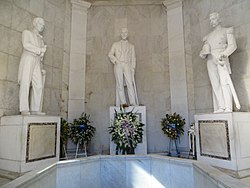 | |
 Meeting between Duarte and the Trinitarios | |
| Named after | The Trinity |
|---|---|
| Formation | July 16, 1838; 185 years ago |
| Founder | Juan Pablo Duarte Juan Isidro Pérez Pedro Alejandro Pina Jacinto de la Concha Félix María Ruiz José María Serra Benito González Felipe Alfau Juan Nepomuceno Ravelo |
| Dissolved | August 22, 1844 |
| Merger of | La Dramatica La Filantropica |
| Type | Revolutionary movement |
| Legal status | Dissolved |
| Purpose | Dominican independence Dominican nationalism |
| Location | |
Official language | Spanish |
| Leader | Juan Pablo Duarte |
Key people | |

La Trinitaria (Spanish: [la tɾiniˈtaɾja], The Trinity) was a secret society founded in 1838 in what today is known as Arzobispo Nouel Street, across from the "Del Carmen's Church" in the then occupied Santo Domingo, the current capital of the Dominican Republic. The founder, Juan Pablo Duarte, and a group of like minded young people, led the struggle to establish the Dominican Republic as a free, sovereign, and independent nation in the 19th century. Their main goal was to protect their newly liberated country from all foreign invasion. They helped bring about the end of the Haitian occupation of Santo Domingo from 1822 to 1844.[1]
Acting in three-person cells and communicating through a complex system of passwords and codes, La Trinitaria focused on a three-pronged message of democracy, representative government, and independence for the Dominican Republic. While they focused on radical ideals, they funneled those ideals through art – members of the group would create intricate theater acts that they would perform anywhere from people’s homes in front of a dozen onlookers to the stage of La Carcel Vieja – where hundreds would look on. The performances were created to build communities and establish unity among Dominicans. Woven within the plays would be revolutionary political messaging that would push the agendas of the Trinitarios. These works led to the exile of Duarte in 1843.
- ^ "Juan Pablo Duarte Square". NYCGovParks.org. 2000. Retrieved 2010-07-26.
© MMXXIII Rich X Search. We shall prevail. All rights reserved. Rich X Search
